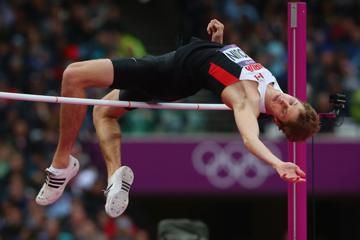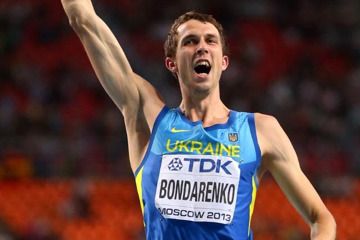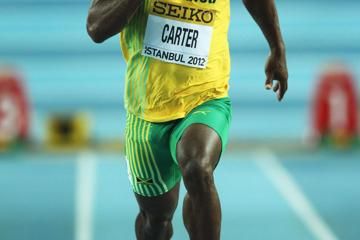US high jumper Erik Kynard at the 2013 IAAF London Diamond League meeting (© Getty Images)
Erik Kynard calls the day he met the high jump “fate”.
As a tall, rail-thin 14-year-old, he joined the school track team in Toledo, Ohio, because his father (Erik Kynard, Sr) had been a sprinter.
But, the younger Kynard recalls: “The runners had to prove fitness with a mile run. My friends and I didn’t want to run a mile, so we headed in to the gym to try the field events.”
Kynard was “automatically” good at the high jump, and decided before the first day was over, “This is what I need to be doing.” That season he cleared six feet (about 1.83m).
Today Kynard, who will turn 23 on 3 February, travels the world to jump, has a PB of 2.37m and a silver medal from the London 2012 Olympic Games, and still sees the high jump as “an event where the crowd has an opportunity to become engaged”.
The greatest year ever
“Field events are longer, and easier to follow,” Kynard says, in contrast with events like the 100m which are over in less time than the average television advertisement. “But they’re not drawn out. At this level, it’s all pretty elite guys, so every jump is interesting.
“This past year [2013] was the greatest the event has ever had in terms of competition,” Kynard asserts. “The level of competition was so high throughout the year.” Bohdan Bondarenko, who attempted world record heights on more than one occasion, “had the kind of year people dream about, and I was there for all of it.”
Kynard’s 2013 didn’t come with a medal, as his 2012 did; he finished fifth (2.32m) in Moscow. He started well, however, and put up good marks all year, beginning with a PB-matching 2.34m in April at the Mt SAC Relays (a world-leading mark at the time), a 2.36m clearance at the Eugene Diamond League in June, and a monster 2.37m clearance in Lausanne in early July, overshadowed only by the 2.41m put up by Bondarenko.
Positive mental attitude
The vertical jumps are unique among field events in that each competition ends with inevitable failure, even for the winners, but Kynard doesn’t see it that way. “It’s not frustrating to me. It’s always a glimpse of a new height, or something you never did before. You have to be an optimist. I always come away with a feeling like, ‘I almost had it this time.’”
To succeed in this environment, Kynard says: “I have to be better than myself, to be the best me I can be. It’s not about me beating the other guys. The only person who can beat me is me. I’m the only one who can knock down the bar. My competitors don’t do that.”
That kind of outlook kept Kynard competitive even as he had a front-row seat to Bondarenko’s audacious heroics. (In London, Bondarenko attempted 2.47m, a full 10cm higher than Kynard’s best). It’s also setting him on his path in his first fully professional season.
After a successful collegiate career which saw him win two NCAA Championships (2011 and 2012) at Kansas State University, Kynard graduated to the professional ranks after the 2013 collegiate season, where he took second in his last NCAA championship meet (to Derek Drouin, bronze medallist in both London and Moscow and the NCAA champion in 2010).
Today, Kynard remains in Kansas, training with coach Cliff Rovelto. “He’s coached all the recent great US high jumpers,” says Kynard, including the winners of the last 12 national titles.
Perception of effort
Kynard’s mental toughness is apparent in a video released by the Kansas State sports information department in May of 2012, in which a well-known basketball player stands under the bar while Kynard jumps over him.
“He wasn’t that tall,” says Kynard, noting that his PB at the time was a solid 10cm higher than the basketballer’s height. He compared the leap to a drill Rovelto’s jumpers do where the pits are stacked to discourage jumpers running through the bar.
But, “perception of the height we actually jump is crazy,” Kynard notes. More than in any other event, high jump suffers in the USA from the inability of most spectators to relate to the real standards being achieved, largely because most Americans don’t have an intuitive feeling for metric distances.
“For us, the sport speaks two different languages,” says Kynard, and with most competitive meets outside the USA announcing heights in meters, hometown fans need visual aids – like basketball players – to understand how high the bar actually is. “It’s an old sport in a new world,” he sighs.
Kynard’s collegiate career benefitted from the parallel development of Canadian jumper Drouin, who first defeated Kynard at the Pan American Junior Championships in 2009, then won the 2010 and 2013 NCAA titles at Indiana State University.
Kynard and Drouin met regularly on the collegiate circuit. “In high school I was jumping about 2.22m [Kynard cleared 2.22m twice as a junior] and everyone else would be finished before I started. With someone like Drouin around, it’s real competition for me.”
Both jumpers will continue facing each other as professionals. “The biggest change in being a professional is that the season is so much later,” Kynard says today. As a collegian, Kynard would have several meetings already under his belt in preparation for the NCAA Indoor Championships in March. This year, he opened his season with 2.31m at a low-key competition in Kansas and his first international competition was on 25 January at the Glasgow International Match where he equalled his indoor PB with 2.33m.
Presuming selection, he says: “The World Indoors [in Sopot] is a target.” Outdoors, Kynard says he plans to compete at “all the Diamond League meetings.”
“I’m looking to slow down and focus on improving specific parts of my competition,” he says of his goals for the year. “This year is for training hard, taking care of my body, and having some fun.”
Barely more than a week after his Glasgow opener, Kynard will celebrate his 23rd birthday, another indication that, like Bondarenko, he’s still just getting started. After his Olympic silver medal, he told a reporter, “I’m young and I’ll be around for a while. I’ll see you all in Rio.”
Parker Morse for the IAAF






